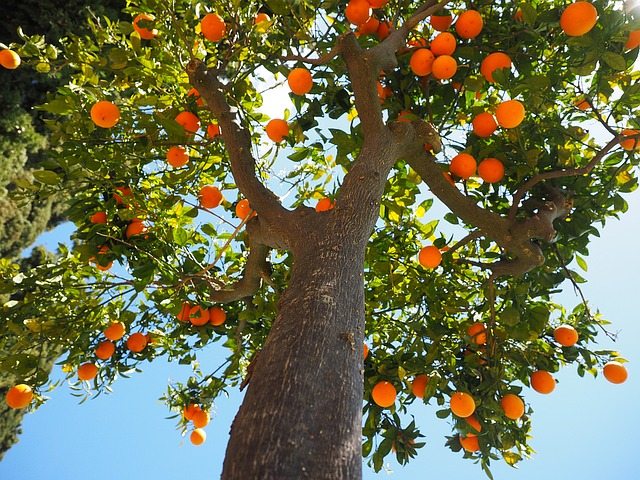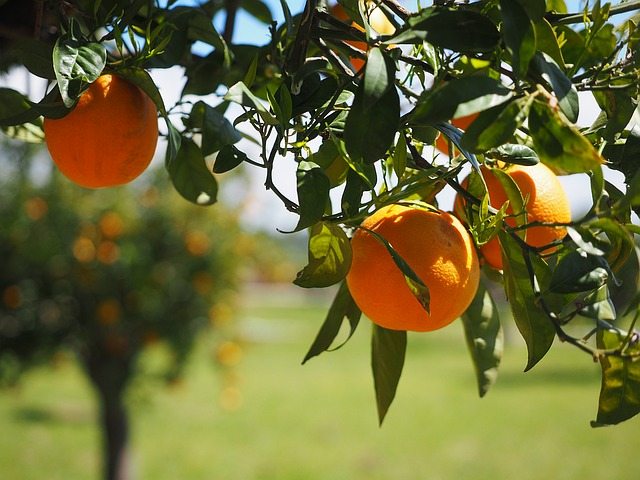Growing Citrus Trees on Drip

Gardening Question from Michelle:
I have a garden that was planted around February which includes dwarf lime, lemon and mandarine. The irrigation is all drip and our watering schedule is for 8 minutes twice a week. I think I’m overwatering the citrus as the leaves on the lemon and lime tree are starting to turn yellow and the lemons aren’t growing or are turning brown. I went to a local nursery for help and was told that citrus shouldn’t be with other plants. They should either be by themselves or in pots. Is this true?

Answer from Pat:
Citrus trees as a group are not well adapted to drip systems but they can survive on regular landscape water and drip systems can be arranged so that they can provide enough water but it is necessary to leave the drip system on for at least an hour and maybe several hours at a time to give citrus trees enough water this way. When they are young citrus trees need, watering three times a week the first week with the hose. Built a water basin around the root ball and apply enough water to thoroughly wet the root ball and surrounding soil. Do the same twice a week for the next four weeks and after that once a week. Once a citrus tree is established the timing of the irrigation can be lengthened. A mature citrus tree may need irrigation on intervals of once every two weeks or one month but the entire area under the canopy of the tree, up to within a foot of the trunk needs to get the equivalent of two or three inches of rain per irrigation. (This is for mature trees.) Some trees can go six weeks between irrigations during winter in rainy years.
Much depends also on drainage. If the soil is clay it retains moisture better and thus irrigations should be deeper but further apart. If the soil is fast draining, the tree must be watered more frequently or it will dry out.
The most important fact to keep in mind is that the soil surrounding the and also the root ball of the tree needs to be moistened until at least one foot deep of the ground becomes wet at each irrigation. It is not enough to sprinkle a little moisture on top.
Drip systems such as you described watering for 8 minutes twice a week could not possibly be giving your trees enough irrigation unless the drip systems gave out a flood of water in 8 minutes that would cover the ground at least one inch deep and sink in. I think they are about to die from lack of water. The fact they haven’t died yet only attests to the rugged, drought-resistant quality of the tree. When trees are not watered enough the first thing the tree does is get rid of its fruit. Then it drops all its leaves in the attempt by so doing that it might survive. That is why your lemons are going brown. They are atrophying from lack of water. If the tree can do it, it will drop them off and next thing to go will be the yellow leaves.
Just figure it out mathematically. Drip systems all have headers and emitters. Emitters are marked with the amount of water that they give off. So whether your trees are getting enough water partly depends on how you have put your system together and how much water the emitter gives off in an hour. Here is an example: Let’s say each tree has 4 emitters surrounding the root ball and each emitter is the kind that gives off one gallon of water per hour. That means your tree would get 4 gallons of water in one hour but would only get 1 gallon in 1/4 hour. In 8 minutes it would only get a little over 2 quarts. Spread that amount of water around the tree and just think how little water you are giving your trees, less than a few cups a week, not enough to even moisten the top of the ground. It is a wonder they are still alive and maybe they have already died.
Another way to figure out how much water plants are getting is to dig down with a trowel and take a look. We had wonderful rains this year and if your trees were planted in clay soil doubtless the ground moisture kept them alive for a while but not this long unless there is some other source of water you haven’t told me about.
Citrus trees also need fertilizer. Citrus are big feeders, and one needs to begin feeding them in February. If you have not watered adequately they were unable to take in any nutrient at all. For detailed instructions, please read pages 63, 64, and 65 in my organic book. But first, for goodness sakes, check the soil, then grab the hose. lay it on the ground with the end stuck in a pot so the force of the water doesn’t dig up the soil and leave the water running slowly for an hour or more in each spot so the water sinks deeply into the ground to irrigate those poor thirsty trees! (But once again, check the soil first to make sure it is dry as a bone as I suspect it is.) Maybe with luck you can still save your trees.
A final note: Far from it being wrong to combine citrus trees with other plants in the landscape, these trees have been used as ornamentals in Mediterranean landscapes for hundreds of years, probably thousands of years. Lemons have cultivated as far north as northern France and Holland, where since the Middle Ages you see them in paintings in gardens where they were brought indoors in winter. Lemons were grown in containers in elegant gardens and at least since the 16th century and maybe earlier brought into heated, glass-fronted, south-facing buildings called “Orangeries” in winter. It is ridiculous to think citrus don’t grow well with other plants. I’ve seldom heard anything more idiotic. But what is NOT good is growing citrus trees in lawns where they get too much water or where the lawn steals all the nutrients needed by the trees, or where the trunks get hit by sprinklers so they fall prey to gummosis, an oozing fungus disease. These are the things that are bad, not the proximity of other plants, which are undoubtedly good since they muddle up the bugs.


Hi
I’m growing an orange tree in my back yard and have a buffalo type lawn around the tree. At the moment, the lawn doesn’t go right up to the trunk of the tree. There is at least a foot clearance from the trunk to the lawn.
My tree is about 4 years old.
How from the base of my orange tree to my lawn should i leave?
I do occasionally also have a sprinkler on for my lawn about every few weeks and fertilize the lawn 2-3 times a year.
Thank you for your help.
David
It is not a good idea to have lawn grass growing over the root zone of a citrus tree because the lawn will compete for water but especially nutrition with the roots of the tree. It would be best if the entire area under the canopy of your orange tree from the trunk to the drip line were free from grass. However, digging the lawn out will be bad for your tree since it will damage feeder roots which are directly beneath the surface of the soil. A better way to get rid of the lawn grass under the canopy of the tree from trunk to the drip line would be to cover the lawn with newspaper and then cover the newspaper with mulch in order to shade out the grass. Do not allow the mulch to touch the trunk of the tree.
I live in Palm Springs. I’m planning on planting a dwarf Mexican improved lime tree and it will be on the irrigation system. I’ve noticed that professional gardeners have sub-surface watering for trees they plant. Can you tell me what you recommend? I can’t water it by hand all year as I’m not a full-time resident so it has to be on the irrigation line, which currently runs 10 mins every day. What’s the right watering nozzle for the tree’s dedicated line, delivered to the root ball instead of at ground level? How many gallons per minute would be needed for what number of nozzles around the root ball to be enough water in 10 minutes every day? I presume the water delivered below grade has to be inside a large pipe, so dirt doesn’t interfere with the watering. As you can tell, I need help! Thank you!
You need to hire a qualified professional landscaper in your area to install the water system for you. They will understand the conditions in Palm Springs and how to install and time the below ground irrigation so that the amount of irrigation is adequate for your tree.
I love your recommendations
You need electric animal tape around the trees set at about 4ft high.
Buffalo love citrus leaves and will destroy your trees very quickly given a chance.
Thank your for your comment.